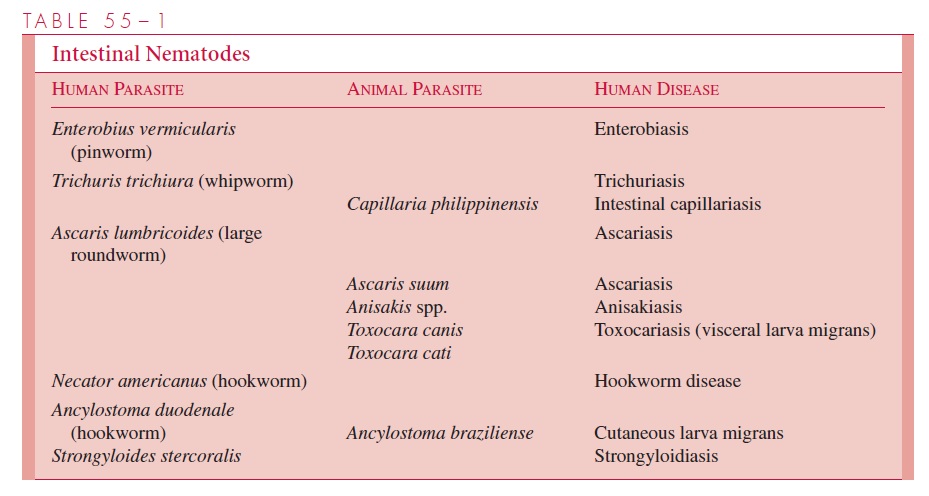Chapter: Medical Microbiology: An Introduction to Infectious Diseases: Intestinal Nematodes
Intestinal Nematodes
Intestinal Nematodes
The intestinal nematodes have cylindric, fusiform bodies covered with a tough, acellularcuticle. Sandwiched between this integument and the body cavity are layers of muscle, longitudinal nerve trunks, and an excretory system. A tubular alimentary tract consisting of a mouth, esophagus, midgut, and anus runs from the anterior to the posterior extremity. Highly developed reproductive organs fill the remainder of the body cavity. The sexes are separate; the male worm is generally smaller than its mate. The female, which is extremely prolific, can produce thousands of offspring, generally in the form of eggs. Typically, the eggs must incubate or embryonate outside of the human host before they become infec-tious to another person; during this time, the embryo repeatedly segments, eventually developing into an adolescent form known as a larva. In some species of nematodes, off-spring develop to the larval stage in the uterus of the worm. The duration and site of em-bryonation differ with each worm species and determine how it will be transmitted to the new host. In many cases, eggs of nematodes that dwell within the human gastrointestinal tract are carried to the environment in the feces and embryonate on the soil for a period of weeks before becoming infectious. The egg may then be ingested with contaminated food. In some species, the egg hatches outside of the host, releasing a larva capable of penetrat-ing the skin of a person who comes in direct physical contact with it. Obviously, intestinal nematodes are principally found in areas where human feces are deposited indiscrimi-nately or used for fertilizer.
Six intestinal nematodes commonly infect humans: Enterobius vermicularis (pin-worm), Trichuris trichiura (whipworm), Ascaris lumbricoides (large roundworm), Neca-tor americanus and Ancylostoma duodenale (hookworms), and Strongyloides stercoralis.
Together they infect more than one fourth of the human race, producing embarrassment, discomfort, malnutrition, anemia, and occasionally death. Other closely related nema-todes of animals that may occasionally infect humans are also listed in Table 55 – 1, but will not be discussed here.

The adults of each of the six nematodes listed previously can survive for months or years within the lumen of the gut. The severity of illness produced by each depends on the level of adaptation to the host it has achieved. Some species have a simple life cycle that can be completed without serious consequences to the host. Less well-adapted para-sites, on the other hand, have more complex cycles, often requiring tissue invasion and/or production of enormous numbers of offspring to ensure their continued survival and dis-semination. Within a given species, disease severity is related directly to the number of adult worms harbored by the host. The greater the worm load or worm burden, the more serious the consequences. Because nematodes do not multiply within the human, small worm loads may remain asymptomatic and undetected throughout the lifespan of the par-asite. Repeated infections, however, progressively increase the worm burden and at some
Although humans can mount an immune response that will eventually lead to the expulsion of worms, it is slow to develop and incomplete. It is therefore the frequency and intensity of reinfection, more than the host’s immune re-sponse, that determine the worm burden. This burden is seldom uniform within affected populations, but rather “aggregated” within subgroups related to their hygienic practices.
Related Topics